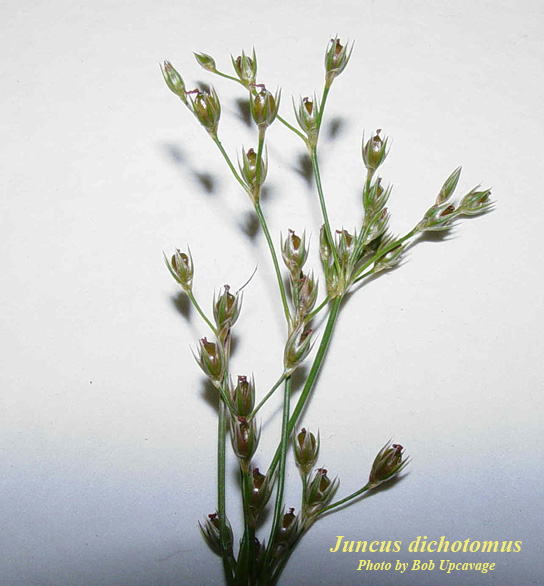Difference between revisions of "Juncus dichotomus"
(→Habitat) |
|||
| Line 1: | Line 1: | ||
{{italic title}} | {{italic title}} | ||
| + | Common names: forked rush <ref name= "USDA"> [https://plants.usda.gov/core/profile?symbol=CEAM USDA Plant Database]</ref> | ||
<!-- Get the taxonomy information from the NRCS Plants database --> | <!-- Get the taxonomy information from the NRCS Plants database --> | ||
{{taxobox | {{taxobox | ||
Revision as of 15:30, 14 June 2018
Common names: forked rush [1]
| Juncus dichotomus | |
|---|---|

| |
| Photo by the Atlas of Florida Plants Database | |
| Scientific classification | |
| Kingdom: | Plantae |
| Division: | Magnoliophyta - Flowering plants |
| Class: | Liliopsida - Moncots |
| Order: | Juncales |
| Family: | Juncaceae |
| Genus: | Juncus |
| Species: | J. dichotomus |
| Binomial name | |
| Juncus dichotomus Ell. | |

| |
| Natural range of Juncus dichotomus from USDA NRCS Plants Database. | |
Contents
Taxonomic Notes
Synonyms: J. dichotomus var. platyphyllus (Wiegand)
Variety: none
Description
J. dichotomus is a perennial graminoid of the Juncaceae family that is native to North America. [1]
Distribution
J. dichotomus is found in the southern United States and much of the east coast; specifically Florida, Georgia, South Carolina, North Carolina, Virginia, West Virginia, Maryland, New Jersey, Pennsylvania, New York, Connecticut, Massachusetts, Vermont, Maine, Rhode Island, Ohio, Kentucky, Indiana, Tennessee, Michigan, Mississippi, Louisiana, Texas, Arkansas, Oklahoma, New Mexico, and Colorado.[1]
Ecology
Habitat
J. dichotomus is often found in disturbed areas such as wet ditches and meadows. [2]
J. dichotomus is not tolerant of drought but has a high fire tolerance. [1]
Phenology
J. dichotomus has only been recorded to bloom in April. [3]
Seed dispersal begins in summer. [1]
Fire ecology
J. dichotomus is not fire resistant. [1]
Use by animals
J. dichotomus is not used by animals for grazing or browse. [1]